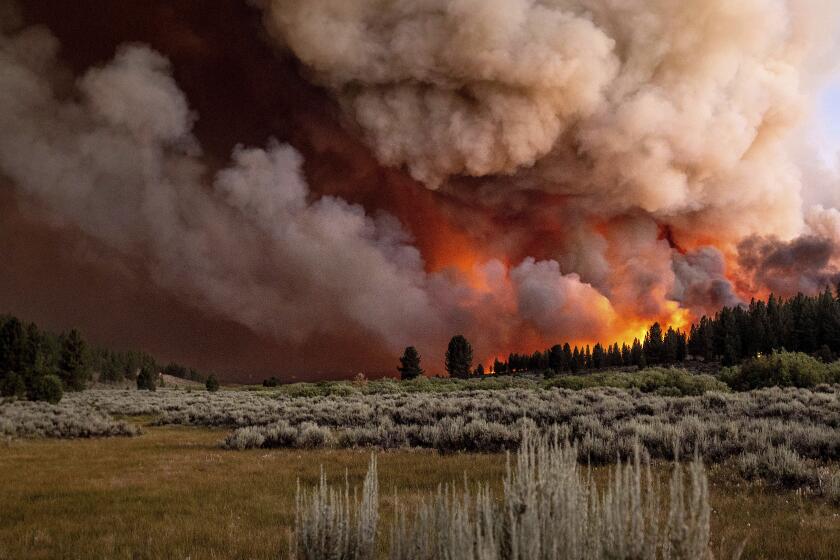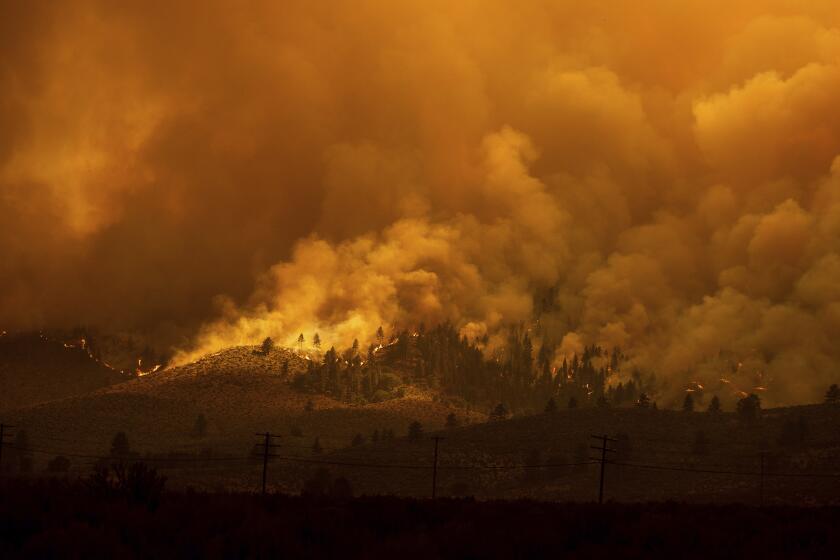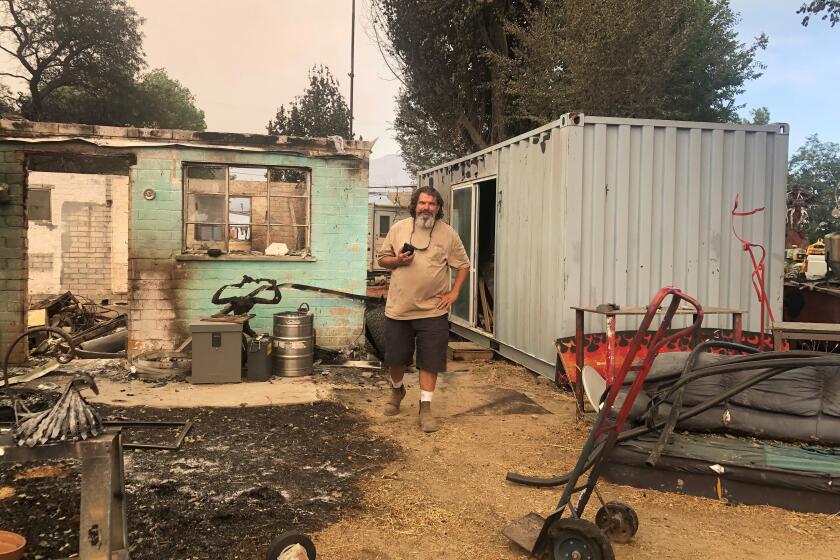Sugar fire becomes California’s first ‘megafire’ of the year as the Dixie fire triples in size

- Share via
As the Dixie fire in Butte County balloons in size, the Sugar fire burning in Plumas National Forest north of Sacramento has become the first 100,000-acre fire in California this year.
The lightning-sparked Sugar fire ignited July 2 and quickly swelled in size as crews battled extreme temperatures and strong gusts of wind.
In the days that followed, spot fires and flareups made it difficult for firefighters to gain a footing on the blaze, officials said. At one point, it grew with such velocity that its massive cloud of smoke, ash and heat generated its own lightning.
As of Friday evening, the Sugar fire had reached 105,163 acres and was 70% contained.
During a morning briefing, U.S. Forest Service Operations Section Chief Jake Cagle said the 100,000-acre “megafire” milestone is no longer uncommon in California, which experienced a record wildfire season in 2020 and is already outpacing those numbers this year.
“These are the new norms now,” Cagle said. “We used to say ‘unprecedented and historic.’ We’re past that now.”
Fueled by a heat wave that exacerbated already hot, dry conditions, the Sugar fire made a huge run Friday, triggering new evacuations for portions of Plumas and Lassen counties.
While much of the Sugar fire’s footprint has been contained, a portion of its western perimeter near Ross Canyon continues to present challenges for the team, according to Cagle.
He said crews began removing surface fuels in the area on Friday but the terrain is “extremely steep and rugged.”
The Sugar fire was one of two fires sparked by lightning in the forest around the same time that together have been dubbed the Beckwourth Complex fire. The second fire, the Dotta fire, started June 30 and was 99% contained at 594 acres Friday.
Combined, they have burned through 105,757 acres.
Fire incident spokeswoman Phyllis Ashmead said California’s recent heat waves and ongoing drought enabled the Sugar fire to become the first to reach “megafire” status this year.
“Primarily it’s the dry fuels that we have, and the low humidities, that are really creating these fires,” she said, noting that this type of fire behavior isn’t typically seen until August or September.
“It’s extremely dynamic. ... And it’s not just here, it’s in many areas. It’s the same conditions throughout California,” she said.
The dryness of the vegetation, primed by both long-term drought and shorter-term heat waves, is making it easy for fires to ignite and even easier for them to spread.
Also of concern is the burgeoning Dixie fire, which more than tripled in size Thursday night to 7,947 acres. By Friday night, it had grown by nearly 1,000 acres.
That fire ignited Wednesday morning and was 9% contained Friday evening, according to the California Department of Forestry and Fire Protection.
The fire is burning in the scar of the 2018 Camp fire but moving north, away from populated areas, said incident spokeswoman Kimberly McGuire. No homes or structures are currently threatened.
McGuire said high winds Thursday propelled the fire’s substantial growth. The area saw heavy winds again on Friday and lightening is expected Sunday and Monday.
“We have a lot of dry fuel, and that wind is really detrimental to the situation right now,” she said.
Residents in the area said the wildfire’s proximity to the Camp fire has stoked reminders of that devastating blaze, which killed more than 85 people and reduced the town of Paradise to ashes.
McGuire said Cal Fire officials are working hard to “reassure them that we are doing our best, and that as of right now, we are really confident and positive that we are able to hold the fire away from the community of Paradise.”
Fire officials are even using some of the containment lines from the 2018 blaze in the fight against the Dixie fire, she said, which is helping create a barrier of protection for residents.
Mandatory evacuations for the High Lake area and from the Butte-Plumas County line from Rock Creek to Tobin remained in place Friday, the Butte County Sheriff’s Office said.
Evacuation warnings are also in effect from east of Tobin to Caribou.
High rents drove Mike Snook out of his arts-collective warehouse in Oakland. He relocated to Doyle, where a wind-swept wildfire wrought devastation.
Although crews are making progress on the Sugar and Dixie fires, conditions in California remain so ripe for ignition that the National Interagency Fire Center’s multiagency coordinating group this week elevated the national preparedness level to 5 — the highest level of wildland fire activity.
The decision was driven by significant fire activity across many areas, the NIFC said in a statement.
“Given the continuing hot and dry weather, the increase in initial attack and large fires in the western U.S., the decision to move to PL 5 depicts the complexity that fire managers are encountering to ensure that adequate firefighting resources are available for protection of life, property and our nation’s natural resources,” the group said.
It is the earliest such designation in 10 years. In 2002, preparedness level 5 was set on June 21, and in 2008, it was set July 1, according to the agency.
Cagle said the Sugar fire’s 100,000-acre milestone will likely be repeated this year, and noted that the North Complex fire in 2020 made a 218,000-acre run in about six hours.
By Friday evening, the Bootleg fire in Oregon’s Fremont-Winema National Forest surpassed 241,000 acres and was only 7% contained, according to the U.S. Forest Service.
Last year also saw California’s first ever million-acre fire, the August Complex, which spread through several counties and sent massive amounts of smoke and ash into the sky.
“This is what we’re going to continue to see until there’s some kind of significant change in our weather patterns, or getting out of the drought,” Cagle said of the Sugar fire’s growth. “That’s what we’re seeing. That’s what every fire is seeing.”
More to Read
Sign up for Essential California
The most important California stories and recommendations in your inbox every morning.
You may occasionally receive promotional content from the Los Angeles Times.















